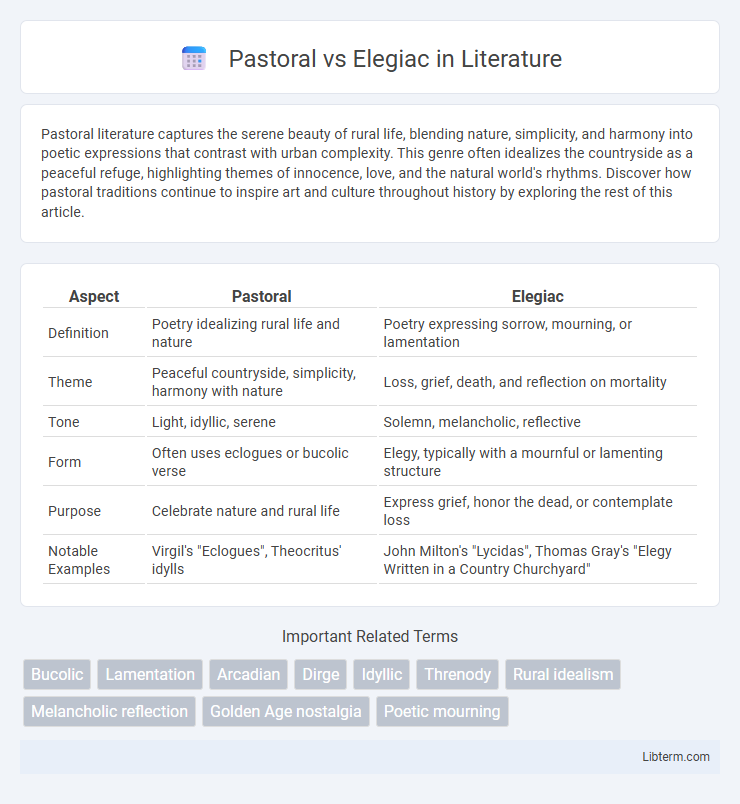Pastoral literature captures the serene beauty of rural life, blending nature, simplicity, and harmony into poetic expressions that contrast with urban complexity. This genre often idealizes the countryside as a peaceful refuge, highlighting themes of innocence, love, and the natural world's rhythms. Discover how pastoral traditions continue to inspire art and culture throughout history by exploring the rest of this article.
Table of Comparison
| Aspect | Pastoral | Elegiac |
|---|---|---|
| Definition | Poetry idealizing rural life and nature | Poetry expressing sorrow, mourning, or lamentation |
| Theme | Peaceful countryside, simplicity, harmony with nature | Loss, grief, death, and reflection on mortality |
| Tone | Light, idyllic, serene | Solemn, melancholic, reflective |
| Form | Often uses eclogues or bucolic verse | Elegy, typically with a mournful or lamenting structure |
| Purpose | Celebrate nature and rural life | Express grief, honor the dead, or contemplate loss |
| Notable Examples | Virgil's "Eclogues", Theocritus' idylls | John Milton's "Lycidas", Thomas Gray's "Elegy Written in a Country Churchyard" |
Introduction to Pastoral and Elegiac Poetry
Pastoral poetry idealizes rural life, celebrating nature, shepherds, and the simplicity of countryside living through vivid, bucolic imagery. Elegiac poetry mourns loss and expresses grief, often reflecting on themes of death, love, and nostalgia with a somber and reflective tone. Both genres originated in classical literature, with Pastoral rooted in works like Virgil's "Eclogues" and Elegiac tracing back to Latin elegies by poets such as Ovid and Propertius.
Historical Origins of Pastoral and Elegiac Genres
Pastoral poetry traces its origins to Ancient Greece, reflecting the idyllic rural life and nature, often attributed to Theocritus in the 3rd century BCE, who crafted bucolic imagery celebrating shepherds and rustic simplicity. Elegiac poetry, emerging concurrently in classical antiquity, is rooted in mourning and lamentation, with early examples found in the works of poets like Callinus and Archilochus who employed elegiac couplets to express sorrow and loss. Both genres evolved through Roman literature, where authors such as Virgil expanded pastoral themes in bucolic poetry, while elegy became a medium for personal and political grief, showcasing their distinct historical trajectories.
Defining the Pastoral: Themes and Characteristics
Pastoral literature idealizes rural life, portraying nature as a peaceful refuge from urban complexity, often featuring shepherds and rustic landscapes to emphasize simplicity and harmony. Key themes include the celebration of nature's beauty, innocence, and a nostalgic yearning for an unspoiled, idyllic existence. The genre frequently contrasts the purity of the countryside with the corruption of city life, highlighting themes of escape, tranquility, and the restorative power of the natural world.
Understanding Elegiac Poetry: Core Elements
Elegiac poetry centers on themes of loss, mourning, and reflection, often expressed through a melancholic tone and personal lament. Core elements include a somber mood, introspective language, and structured meter such as the elegiac couplet, which enhances the poem's rhythm and emotional impact. This genre contrasts with pastoral poetry by emphasizing sorrow and human mortality rather than idyllic rural life and nature.
Key Differences between Pastoral and Elegiac Forms
Pastoral poetry typically idealizes rural life and nature, portraying shepherds and countryside settings with themes of simplicity and harmony. Elegiac poetry, on the other hand, centers on mourning and loss, often expressed through personal grief or reflection on mortality. Key differences include the pastoral's celebration of bucolic tranquility versus the elegiac's somber tone and themes of sorrow and remembrance.
Major Pastoral Poets and Their Works
Major pastoral poets include Theocritus, known for "Idylls," and Virgil, whose "Eclogues" are seminal in the genre, celebrating rural life and nature's simplicity. Pastoral poetry idealizes shepherds and rustic landscapes, contrasting with elegiac poetry, which centers on themes of loss and mourning, exemplified by poets like Ovid and Propertius. The pastoral tradition influenced Renaissance poets such as Edmund Spenser, whose "The Shepherd's Calendar" blends idyllic countryside imagery with allegorical depth.
Notable Elegiac Poets and Representative Texts
Elegiac poetry, often characterized by themes of mourning, loss, and reflection, contrasts with pastoral poetry's idealization of rural life. Notable elegiac poets include Ovid, whose "Amores" and "Tristia" explore love and exile, and Thomas Gray, renowned for "Elegy Written in a Country Churchyard," which contemplates death and the common man's life. Other key texts are Albius Tibullus's "Elegies" and Propertius's collections, which deepen the genre's introspective and personal dimensions.
The Function of Nature in Pastoral vs Elegiac Poetry
Pastoral poetry idealizes nature as a serene, harmonious backdrop where rural life unfolds peacefully, symbolizing innocence and simplicity. Elegiac poetry, by contrast, employs nature to evoke themes of loss, mourning, and the passage of time, often highlighting its transient and melancholic aspects. The function of nature in pastoral centers on celebration and escapism, while in elegiac it underscores reflection and emotional depth.
Contemporary Relevance of Pastoral and Elegiac Modes
Pastoral poetry offers a contemplative refuge through depictions of rural life, emphasizing harmony between humans and nature, which resonates with modern environmental concerns and urban disconnection. Elegiac poetry remains vital by providing a structured outlet for processing grief and loss, mirroring contemporary experiences of trauma and mourning. Both modes adapt classical themes to address current emotional and ecological challenges, reflecting their enduring relevance in today's literary landscape.
Conclusion: The Enduring Legacy of Pastoral and Elegiac Traditions
Pastoral and elegiac traditions maintain a profound legacy by capturing the complexities of human emotion through contrasting themes: the serene idealization of rural life in pastoral poetry and the poignant reflection on loss in elegiac verse. Their enduring influence shapes contemporary literature by providing timeless frameworks for exploring nature, mortality, and memory. These genres continue to inspire artistic expression, affirming their relevance in understanding cultural and emotional landscapes.
Pastoral Infographic

 libterm.com
libterm.com